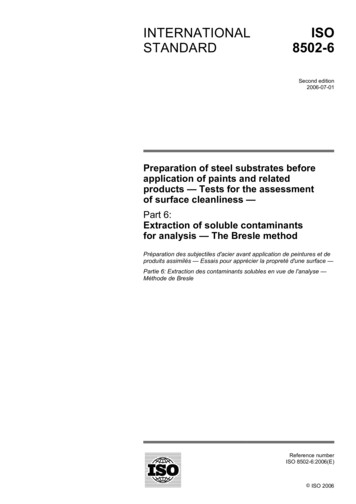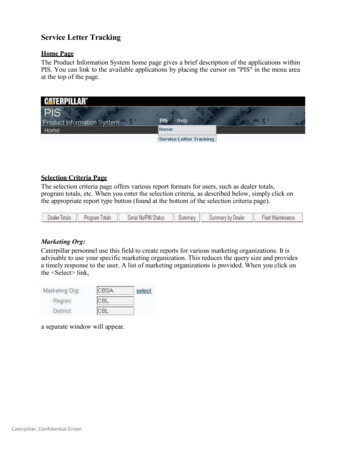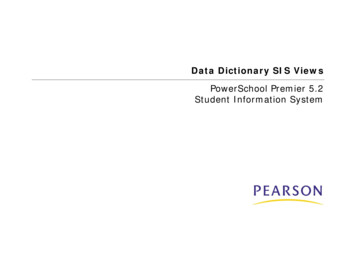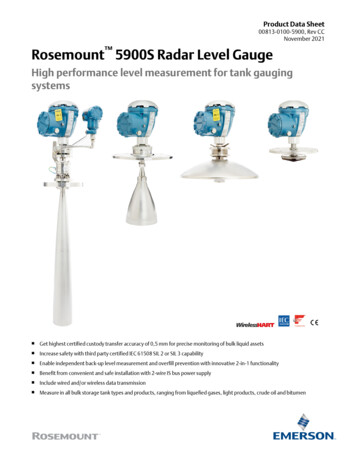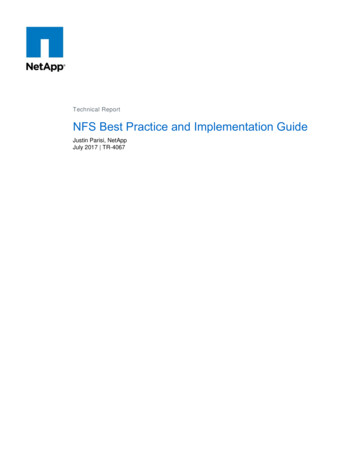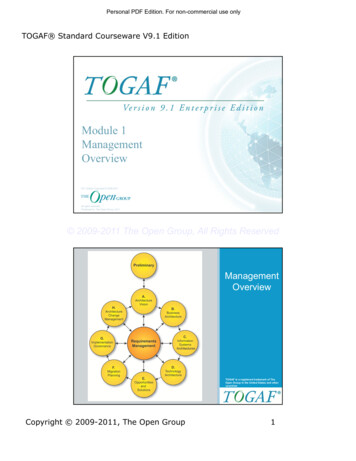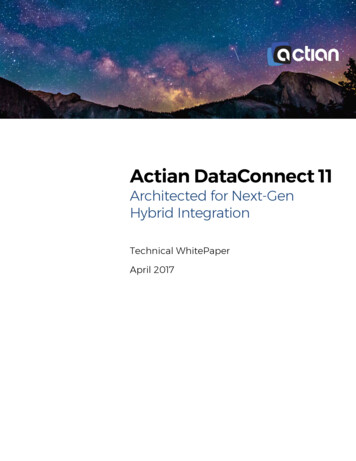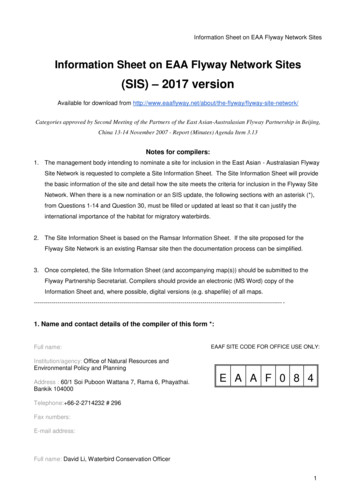
Transcription
Information Sheet on EAA Flyway Network SitesInformation Sheet on EAA Flyway Network Sites(SIS) – 2017 versionAvailable for download from ite-network/Categories approved by Second Meeting of the Partners of the East Asian-Australasian Flyway Partnership in Beijing,China 13-14 November 2007 - Report (Minutes) Agenda Item 3.13Notes for compilers:1. The management body intending to nominate a site for inclusion in the East Asian - Australasian FlywaySite Network is requested to complete a Site Information Sheet. The Site Information Sheet will providethe basic information of the site and detail how the site meets the criteria for inclusion in the Flyway SiteNetwork. When there is a new nomination or an SIS update, the following sections with an asterisk (*),from Questions 1-14 and Question 30, must be filled or updated at least so that it can justify theinternational importance of the habitat for migratory waterbirds.2. The Site Information Sheet is based on the Ramsar Information Sheet. If the site proposed for theFlyway Site Network is an existing Ramsar site then the documentation process can be simplified.3. Once completed, the Site Information Sheet (and accompanying map(s)) should be submitted to theFlyway Partnership Secretariat. Compilers should provide an electronic (MS Word) copy of theInformation Sheet and, where possible, digital versions (e.g. shapefile) of all ------------------------------ -1. Name and contact details of the compiler of this form *:Full name:EAAF SITE CODE FOR OFFICE USE ONLY:Institution/agency: Office of Natural Resources andEnvironmental Policy and PlanningAddress : 60/1 Soi Puboon Wattana 7, Rama 6, Phayathai.Bankik 104000E A A F 0 8 4Telephone: 66-2-2714232 # 296Fax numbers:E-mail address:Full name: David Li, Waterbird Conservation Officer1
Information Sheet on EAA Flyway Network SitesInstitution/agency: Wetlands InternationalAddress : 3A39, Block A. Kelana Centre Point, SS7/19, 47301,Patling Jaya, Selangor, MalaysiaTelephone: 603 7804 6770Fax numbers: 603 7804 6772E-mail address: david@wiap.nasionet.netFull name: John HowesInstitution/agency: Wetlands International Associate Experts,Luscinia ConsultingAddress : No. 17 Jalan 14/34, 46100 Petaling Jaya, SelangorD.E., MalaysiaTelephone: 603 79602526Fax numbers:E-mail address: johnhowes@pd.jaring.my2. Date this sheet was completed *:DD/MM/YYYY9th November 20053. Country *:Thailand4. Name of the Flyway Network site *:Accepted English transcription of the Site‟s name.Krabi Estuary and Bay5. Map of site *:The most up-to-date available and suitable map of the wetland should be appended to the SIS (only in digitalformat and shape file). The map must clearly show the boundary of the site. Please refer to the “DigitisingSite Boundaries in Google Earth” file linked here.(See below.)2
Information Sheet on EAA Flyway Network SitesMap 1: Boundary of the Krabi Ramsar site.3
Information Sheet on EAA Flyway Network SitesMap 2: Most important feeding and roosting areas for shorebirds in Krabi Estuary and Bay.Ramsar Site BoundaryIntertidal habitatAbove high-tide level6. Geographical coordinates (latitude/longitude, in decimal degrees) *:Provide the coordinates of the approximate centre of the site and/or the limits of the site. If the site iscomposed of more than one separate area, provide coordinates for each of these areas.7 50 to 8 05 N and 98 48 to 99 01 E4
Information Sheet on EAA Flyway Network Sites7. Elevation *: (in metres: average and/or maximum & minimum)Sea level8. Area *:The total area of the site, in hectares. If the areas of discrete site units are known, please also list each ofthese together with the names (or labels) used to identify and differentiate these units.21,299.14 ha9. General overview of the site *:A brief (two sentences) summary of the site, mentioning principal physical and ecological functions, and itsimportance for migratory waterbirds.Krabi Estuary and Bay is a Ramsar Wetland which includes sand beaches, mangroves andsand-flats extending from the fossil mollusc beds at Laem Pho to Khao Kanab Nam, KhaoLaem Nang, east past the complex of rivers which open to the sea at Pak Nam Krabi, to theKhlong Yuan and Khlong Taling Chan, and south to Ban Laem Hin and Sriboya Island. TheRamsar site encompasses considerable areas of steep wooded cliffs and plantationagriculture (Map 1). The inter-tidal mudflats extend up to two km wide at low tide. The areaof mangrove forest and mudflats are 10,212 ha and 1,200 ha respectively (Map 2). Asubstantial amount of fresh water enters the system as run-off via the major rivers,especially during the wet season. The sea-bed shelves fairly steeply to two metresimmediately offshore, and to 6-10 m in the major estuary. The tidal amplitude at Ao Nangvaries from 1m at neap tides to 3m at the highest spring tides. Important high-tide roostsites for shorebirds are on the numerous bamboo fish-traps up to 3 km offshore as well ason the sand beaches at Khlong Thalu, Laem Pho and Laem Kam.This site was listed as a Ramsar site by the Thailand Government on 5 th July 2001.Unfortunately much of the inter-tidal sandflats and all of the important fish-trap roost siteswere excluded from the Ramsar site. The Danida-funded project “Implementing the RamsarConvention in Thailand: Management and Protection of Wetlands (MPW)” maderecommendations in 2002 to extend the westward boundary of the Ramsar site as far asthe 5m depth contour of the sub-littoral shelf to include all shorebird roosts and theextensive sea grass beds around Sriboya and Pu islands. In the future this area will beconsidered for inclusion in the Ramsar site boundary as part of the shorebird managementarea.10. Justification of Flyway Site Network criteria *:Please provide waterbird count information (with year of latest count) that demonstrates that the site meetsthe criteria of the Flyway Site Network (Annex 1). That is: it regularly supports 20 000 migratory waterbirds; or,5
Information Sheet on EAA Flyway Network Sites it regularly supports 1 % of the individuals in a population of one species or subspecies ofmigratory waterbird; or, it supports appreciable numbers of an endangered or vulnerable population of migratory waterbird it is a “staging site” supporting 5 000 waterbirds, or 0.25% of a population stage at the site.A listing of the populations of migratory waterbirds covered by the East Asian – Australasian FlywayPartnership and the 1% thresholds is attached (Annex 3).The “staging site” criterion is particularly difficult to apply and application of this should be discussed with theSecretariat. Also note that some species have several populations that are very difficult to distinguish in thefield.Highest counts of shorebirds at the site are 2000 in October 1984 by aerial survey, 1,760during September 1988, and more recently 3,550 shorebirds in November-December 2003and the highest count of 4,782 shorebirds recorded in March 2004. „it regularly supports 1 % of the individuals in a population of one species or subspeciesof migratory shorbird‟Two migratory shorebird species have met the 1% population criteria: the Mongolian Plover(Lesser Sand Plover) and the Nordmann‟s Greenshank (Table 1). „it is a “staging site” where at least 0.25% of a population stage at the site.‟Krabi Estuary appears to be a staging site for the migratory passage of several populationsof shorebirds. The site has met the selection criteria as a staging site for two species, theGreater Sand Plover and Kentish Plover (see Table 1). These species were not recorded inlarge numbers during the non-breeding season and as such are considered to be passagemigrants.Table 1: Shorebirds in Krabi Estuary which meet the criteria for the East AsianAustralasian Shorebird Site b1%alCriteristatuas1,300Highest count3,571 in March2004, by tsStagingCriteriaYes6
Information Sheet on EAA Flyway Network SitesSpeciesNordmann’sGreenshankTringa guttiferGlob1%alCriteristatuas6Highest countEN*40 duringDecember 1996 byE.T. Myers.20 in March 1991,AWC data.Greater Sand1,000PloverCharadriusleschenualtiiKentish Plover agingCriteria10 in Jan Yes2001, by PhilD. Round7 in March2004,byJohn Howes300 on 22 April2004, by JohnHowesYes300 on 5 March2004, by JohnHowesYes* EN Endangered under the IUCN Red List Category (2004) „it supports appreciable numbers of an endangered or vulnerable population of migratoryshorebird.‟The Krabi Estuary and Bay is important for Nordmann‟s Greenshank (Endangered species,IUCN), particularly during the winter (non-breeding season) and as a site during northwardmigration for birds returning from farther south. Based upon the records during 1991 to 2004(presented in Table 2), the earliest recorded date at Krabi during the Autumn (southwardmigration) is 2nd November (in 2000) and the latest date during Spring (northward migration)is 9th April (in 1995). A maximum winter (non-breeding) season count of 40 birds wasrecorded on 20 December 1996 by E.T. Myers. Based on these figures the Krabi Estuaryand Bay was most important for Nordmann‟s Greenshank during the years 1996 and 1997.Many of these counts were made during high tide when the birds roost on bamboo fish-trapsoffshore of the actual Ramsar site.Table 2: Historical records of Nordmann’s Greenshank at Krabi Estuary (extracted fromthe AWC database and visiting birders log book for Dec 1993 – March 2001 at “May andMark Restaurant”, Krabi Town, and some survey results)DateMarch 1991Dec 1991January 1993January 199426 January 1994Number203542Observer(s) Names and NationalityAWC VolunteerAWC VolunteerAWC VolunteerAWC VolunteerG and N Find (UK)7
Information Sheet on EAA Flyway Network Sites3 April 19946 March 19959 April 199520 November 199520 December 199528-31 January 199627 February 19968 December 199620 December 199627 November 19967 March 199726 March 19973 April 1997216-8Yes1YesMinimum2Ca. 3540 121 9 153 April 199729 November 19977 December 19981 January 199920 March 20002 November 200025 January 200111 March 20014-5 December 20035 March 200474152110527Brian (?) (UK)Felix JackmanM. Golley, C. Still, B and A Rabbit (UK)M-F Mourrain (France)Olaf A, and J. Pettersson, (Sweden)J. Rogers and T. Pallister (Australia)T. Allwood and D. Bonsall (UK)E.T. MyersE.T. Myers, D. Judel and P. HolmesC. Carpenter (Nepal)E.T. MyersLeigh Lock (UK)C. Gibbons, M. Hunter, N. Antcliff, P. Cook, R.Aberdeen (UK)T. Palliser (Australia)P. Zakowski (UK)Brad and Jennifer (USA), Colin (UK)D. MacDonald (UK), P. Wessels (South Africa)Volker Erdelen (Germany).M. Green (Sweden)P.D. RoundN and D Crock (USA and UK)John HowesJohn Howes11. Wetland Types *:List the wetland types present (see Annex 2). List the wetland types in order of their area in the FlywayNetwork site, starting with the wetland type with the largest area.Marine and Coastal Wetlands : A, B, C, D, E, F, G, I, JAPermanent shallow marine waters less than six metres deep at low tide; includes seabays and straits.BMarine subtidal aquatic beds; includes kelp beds, sea-grass beds, tropical marinemeadows.CCoral reefs.DRocky marine shores; includes rocky offshore islands, sea cliffs.ESand, shingle or pebble shores; includes sand bars, spits and sandy islets; includesdune systems.FEstuarine waters; permanent water of estuaries and estuarine systems of deltas.GIntertidal mud, sand or salt flats.HIntertidal marshes; includes salt marshes, salt meadows, saltings, raised salt marshes;includes tidal brackish and freshwater marshes.8
Information Sheet on EAA Flyway Network SitesIIntertidal forested wetlands; includes mangrove swamps, nipah swamps and tidalfreshwater swamp forests.JCoastal brackish/saline lagoons; brackish to saline lagoons with at least one relativelynarrow connection to the sea.KCoastal freshwater lagoons; includes freshwater delta lagoons.12. Jurisdiction *:Include territorial, e.g. state/region, and functional/sectoral, e.g. Ministry of Agriculture/Dept. of Environment,etc.Most of the mangrove forests in the Krabi estuary were previously under concession forcharcoal production, and this terminated in 2001. Since then the mangrove forests havebeen largely unmanaged and have reverted to community forestry and biodiversityconservation needs. The Khlong Chilat mangroves and the 45 million year old fossilmollusc beach at Laem Pho are part of the Had Nopparat Tara Pi Pi Island Marine NationalPark, which is state-owned land.13. Management authority *:Provide the name and address of the local office(s) of the agency(ies) or organisation(s) directly responsiblefor managing the wetland and the title and/or name and email address/phone number of the person orpersons in this office with direct responsibility for managing the wetland.1) Mangrove Forest Management Unit 3 and Unit 4Department of Marine and Coastal2) Krabi MunicipalityUtrakij Road, Muang District, Krabi Province 81000Thailand.Tel. 66-75- 611120, Fax. 66-75-62060314. Bibliographical references *:A list of key technical references relevant to the wetland, including management plans, major scientificreports, and bibliographies, if such exist. Please list Web site addresses dedicated to the site or whichprominently feature the site, and include the date that the Web site was most recently updated. When a largebody of published material is available about the site, only the most important references need be cited, withpriority being given to recent literature containing extensive bibliographies.1) Howes, J., Nutcharin Kleawkla, and Vitoon Sirisarntiphong. (2004). Implementation of theRamsar Convention in Thailand: Management and Protection of Wetland Areas. WetlandEcology Component: Ecological Characterisation of Krabi Estuary and Bay. Final Report.MPW and ONEP, Bangkok.9
Information Sheet on EAA Flyway Network Sites2) IUCN (2004). 2004 IUCN Red List of Threatened Species www.redlist.org .Downloaded on 05 Sept 2005.3) Parr, John W.K.(1988). A Evaluation of Mangroves and Mudflats at Krabi, South Thailand,A Project of the Asian Wetland Bureau in co-operation with the Royal Thai ForestDepartment, December 1988.4) National Inventory of Natural Wetland: Southern Part of Thailand, Office of EnvironmentalPolicy and Planning, Bangkok, October, 2000.5) Scott, Derek A. and Jintanukul, J.(1988). A Directly of Asian Wetlands, IUCN, The WorldConservation Union, p.728-729.6) Bird Conservation Society of Thailand (2001). The Survey of Bird Habitat in Non-HuntingArea and Important Estuaries in the Southern Part of Thailand, Interim Report, January2001.7) AWC 1987-2001 data.15. Physical features of the site:Describe, as appropriate, the geology, geomorphology; origins - natural or artificial; hydrology; soil type;water quality; water depth, water permanence; fluctuations in water level; tidal variations; downstream area;general climate, etc.Krabi Estuary consists of a low-lying coastal plain that is intersected by three main riverchannels and various smaller channel features. There is evidence of successive low duneformation and the western-facing coast is dominated by sandy beaches with 1-2 km widesandy inter-tidal zones. Immediately offshore is a 6 km wide, shallow ( 5m.) in-shore shelfwith some isolated islets. Altitude approx. 5 m below sea level to approx. 30 m above sealevel with isolated hills at 100 m.The total area of the Krabi Estuary and Bay Ramsar site is 21,299 ha. Of this 7,303 ha. (ca.34%) is inter-tidal mangrove forest and approximately 2,259 ha. (10.6%) is inter-tidal sandflat. The remainder is either water (river channels and sea) or under other land use(agriculture, towns and villages, etc) or other natural vegetation (beach forest, limestonekarst forest, etc).The coastline of the Ramsar site is dominated by three major river estuaries which emptyinto Krabi Bay and the Andaman Sea. These are, the combined estuary of the KhlongChilat and Pak Nam Krabi, the Khlong Yuan and the Khlong Phela and a much smaller inlet(Khlong Thalu)The currents, waves and sediments movements along the coast are dominated by threemajor estuaries that empty into the Bay (these are described above along with some detailson sediments and movements). Sediment loads from the other inlets are considerably less10
Information Sheet on EAA Flyway Network Siteswith minor sediment plumes up to 2 km offshore. Much of the sediment along the coastappears to have originated from the Pak Nam Krabi, as dictated by long-shore drift.Tidal records from Krabi Bay indicate that the tidal cycle is “harmonic” in nature. The SpringTide ranges between 2.7 and 2.8m and a Neap tide ranges between 0.83 and 0.86 m.The freshwater drainage of Krabi Province is dominated by River Basin No. 25: PeninsulaWest Coast as defined by the Royal Irrigation Department, Hydrology Division, Bangkok.The climate of the Krabi Estuary and Bay is typical of the tropical monsoon-type climate ofSouth Thailand and South-east Asia as a whole. The region is characterised by high annualaverage temperatures of around 30oC with rates of relative humidity in excess of 80% andhigh levels of annual rainfall (around 2,000 mm per annum). Due to its coastal location, thearea is heavily influenced by the West and North-east Monsoons (May-October andNovember-April respectively). The majority of the rainfall occurs at the end of the WestMonsoon (and during the inter-monsoon period) in September and October and thestrongest winds (99 knots) recorded during the NE Monsoon.Monthly temperatures in Krabi Town range between a minimum mean of 23.3 oC and amaximum mean of 32.5 oC. March is generally the hottest month with a maximum mean of34.6 oC whilst December and January have the coolest temperatures with a minimum meanof 22.2 oC. On the island of Ko Lanta the mean relative humidity is 80%, with a minimum of74% in October and 86 % in January.16. Physical features of the catchment area:Describe the surface area, general geology and geomorphological features, general soil types, and climate(including climate type).17. Hydrological values:Describe the functions and values of the wetland in groundwater recharge, flood control, sediment trapping,shoreline stabilization, etc.The principal values of Krabi Estuary are sediment trapping, transportation andmaintenance of seawater quality.18. General ecological features:Provide further description, as appropriate, of the main habitats, vegetation types, plant and animalcommunities present in the Flyway Network site, and the ecosystem services of the site and the benefitsderived from them.11
Information Sheet on EAA Flyway Network SitesKrabi Estuary and Bay includes a diverse array of mangrove forest communities along withinter-tidal sand-flats, limestone karst formations with evergreen forest, a fossil molluscbeach, coral reefs and seagrass meadows.19. Noteworthy flora:Provide additional information on particular species and why they are noteworthy indicating, e.g., whichspecies/communities are unique, rare, endangered or biogeographically important, etc. Do not include heretaxonomic lists of species present – these may be supplied as supplementary information to the SIS.(Please add here the species which do not come under sec no 14)Six broadly characteristic types of vegetation assemblage are found in the Krabi Estuaryand Bay Ramsar site. These are mangrove forests, swamp forests and sea grass beds (themajor “wetland assemblages”) and limestone karst forest, beach forests and agriculture(mostly non-wetland assemblages).Mangroves are the dominant vegetation assemblage in the Krabi Estuary and Bay. Theyare predominantly found throughout the shallow inter-tidal zone in areas that are influencedby the daily tidal variation. In Krabi, mangrove forests also occur along the landward marginof the inter-tidal zone in areas that are not directly affected by daily tidal fluctuations butmay be during the highest tides each month – these areas are known as “back-mangal” ormangrove transition zone.Fifty species of mangrove plants and mangrove associated plant species have beenrecorded in the Krabi Estuary and Bay. This includes 25 species of “true” mangroves (i.e.,plant species that are fully adapted to inter-tidal ecosystems) and 26 “associated” plantspecies (i.e., plant species that have some adaptations to inter-tidal conditions but are notrestricted to this ecotone).“True” Mangroves include Acanthus volubilis, A. ilicifolius, Avicennia alba, A. marina, A.officinalis, Lumnitzera littorea, L. racemosa, Exoecaria agallocha, Xylocarpus mekongensis,X. granatum, Aegiceras corniculatum, Nypa fruticans, Rhizophora apiculata, R, mucronata,Bruguiera cylindrica, B. gymnorrhiza, B. hainsii, B. parviflora, Ceriops decandra, C. tagal,Scyphiphora hydrophyllacea, Merope angulata, Sonneratia caseolaris, S. alba, Heritieralittoralis.“Mangrove Associates” include Cerbera odollam, Finlaysonia obovate, Dolichandronespathacea, Terminalia catappa,Barringtonia asiatica, Derris trifoliata, D. indica,Caesalpinia crista, C. bonduc, Hibiscus tiliaceus, Thespesia populnea, Phoenix paludosa,Acrostichum aureum, A. speciosum,Atalantiamonophylla,CordiaBrownlowia tersa, Amoora (Agalaia) dica,12
Information Sheet on EAA Flyway Network SitesPentaspadon velutinus, Pluchea indica, Premna obtusifolia, Sesuvium portulacastrum,Tristellateia australasiaeOther natural assemblages only occur in small areas or discrete zones. These include seagrass beds in the inter-tidal and sub-tidal areas, beach forest and beach vegetation alongthe sandy beach ridges and crests, small areas of Melaleuca swamp forest in Taling Chanand at Laem Pho and limestone karst forest on the numerous limestone outcrops in thearea.Most other vegetation assemblages within the site are man-made agricultural systems –rice fields, Para rubber plantation and oil palm plantations.20. Noteworthy fauna:Provide additional information on particular species and why they are noteworthy (expanding as necessaryon information provided in 10. Do not include here taxonomic lists of species present – these may besupplied as supplementary information to the SIS.(Please add here the species which do not come under sec no 14)A full list of shorebirds species recorded at Krabi Estuary is in Table 3. Of a total 27 speciesof shorebirds recorded here, 25 are migratory species (Table 1).Other waterbird species recorded include Grey Heron Ardea cinerea, Roseate Tern Sternadougallii, Great Crested Tern S. bergii and Lesser Crested Tern S. bengalensis) A recentrecord of Indian Cormorant Phalacrocorax fuscicollis, once confirmed, would be a first forpeninsular Thailand.Table 3: Highest counts of Shorebirds recorded in KrabiEstuarySpeciesBlack-wingedStiltGrey PloverGlobal1%statuCriteria s1300Pacific Golden 1,000PloverMongolian1,300PloverRecent CountsMaximum count(2000-2004)A pair in October 2002,John Howes150 in Mar 1991, AWC 79inMarchrecord2004,JohnHowes112 in Nov 2003, John 112 in Nov 2003,HowesJohn Howes3,571 in March 2004, JohnHowes13
Information Sheet on EAA Flyway Network SitesSpeciesGlobal1%statuCriteria sGreater Sand 1,000PloverKentish Plover eGrey-tailedTattlerGreat Knot1,000Red s3,2001,600230NT55065004003,8001,8001,000ENMaximum countRecent Counts(2000-2004)300 on 22 April 2004, byJohn Howes300 on 5 March 2004, byJohn Howes200 in Mar 1991, AWC 150,Octoberrecord200, John Howes60 in Jan 1994, AWCrecord4 in Mar 1992, B. Barnacal 2 in November2003,JohnHowes54 in Sep 1988, AWC 30 , May 2000,recordChris Gooddie80 in October 2002, JohnHowes50 in Nov 1997, Chris 25 in NovemberGooddie2003,JohnHowes120 in November 2003,John Howes40 duringDecember 10 in Jan 2001,1996, E.T. Myers.Phil D. Round20 in March 1991, AWC 7 in March 2004,data.John Howes2 in November 2003, JohnHowes450 in Jan 1999, by P.D. 370 in MarchRound2004,JohnHowes15 in Mar 1991, AWC 5 in Novemberrecord2003,JohnHowes60 in April 2004, JohnHowes1 in April 2004, JohnHowes105 in Nov 2003, JohnHowes2 in May 1996, ECristopherson100 in April 2004, JohnHowes20 in Dec 1991, AWCrecord25 in Mar 1991, AWC14
Information Sheet on EAA Flyway Network SitesSpeciesStintSanderlingGlobal1%statuCriteria ng (nonmigrant)NTRecent Counts(2000-2004)Maximum countrecord25 in February 2004, JohnHowes3 in Sep 1988, AWC 2 in Novemberrecord2003,JohnHowesA pair in October 2002 andFebruary2004,JohnHowesAt least 222 bird species are found in the mangrove area. This includes at least 6 GloballyThreatened species, Christmas Island frigate bird Fregata andrewsi (Critical Endangered),Nordmann‟s Greenshank Tringa guttifer (Endangered); Lesser Adjutant Leptoptilos javanicus,Chinese Egret Egetta eulophotes, black-faced spoonbill (Platalea minor)and Masked FinfootHeliopais personata (Vulnerable),and 4 Near Threatened species Malaysian ploverCharadrius peronii, Asian dowitcher Limnodromus semipalmatus, Mangrove Pitta Pittamegarthyncha and White-chested Babbler Trichastoma rostratum.Mangrove associated species include the Mangrove pitta Pitta megarhyncha, Mangroveblue flycatcher Cyornis rufigastra, Brown-winged kingfisher Pelargopsis amauroptera,Ruddy kingfisher Halcyon coromanda, Greater flameback Chrysocolaptes lucidus, Streakbreasted Woodpecker Picus viridanus, Great tit Parus major, Copper-throated sunbirdNectarinia calcostetha, Chestnut-bellied malkoha Phaenicophaeus sumatranus, Mangrovewhistler Pachycephala grisola.Other bird species include the Ashy-throated Warbler Phylloscopus maculipennis, Ediblenest Swiftlet Aerodramus fusciphagus, Black-nest Swiftlet A.maximus, White-belliedWoodpecker Dryocopus javensis and Great Slaty Woodpecker Muelleripicus pulverulentus.Krabi Estuary and Bay is of surprisingly high significance for marine mammals (cetaceans),with up to 20 species possibly occurring in the area and confirmed sightings or strandingsof at least 10 species. These include IUCN “Globally Threatened” species such as Bryde‟swhale (Balaenoptera edeni), sperm whale (Physeter macrocephalus), false killer whale(Pseudorca crassidens) and killer whale (Orcinus orca) as well as commoner smallercetaceans such as bottlenose dolphin (Tursiops aduncus), finless porpoise (Neophocaenaphocaenoides) and hump-backed dolphin (Sousa chinensis).15
Information Sheet on EAA Flyway Network SitesThree species of marine turtle are regularly recorded within the Krabi Estuary and Bay, themost common of these is the IUCN “Critically Endangered” hawksbill turtle (Eretmochelysimbricata). The other species are the IUCN “Globally Endangered” species green sea turtle(Chelonia mydas) and olive-ridley turtle (Lepidochelys olivacea).At least 17 species of terrestrial mammals have also been recorded at Krabi, these includewetland dependent species such as the smooth otter (Lutrogale perspicillata), Asian shortclawed otter (Aonyx cinerea), fishing cat (Prionailurus viverrinus) and crab-eatingmongoose (Herpestes urva). The most dominant mammal species in the mangrove forestsis the long-tailed or crab-eating macaque (Macaca fascicularis).Of the 29 species of terrestrial reptiles recorded at Krabi, only four are commonly found inthe mangrove forest, these are Draco maculatus, Varanus salvator, Boiga dendrophila andTrimeresurus purpureomaculatus. All other species are commonly found in the plantationand abandoned agricultural areas but will also use mangrove forests to a limited extent.Only one species of amphibian is adapted to live in the brackish water mangrove habitat atKrabi. Rana cancrivora (the mangrove frog) is able to withstand the mildly saline conditionsin the back mangal. The other 7 species of amphibian are all characteristic of disturbedhabitats such as plantations, villages and agricultural areas. The most abundant is thecommon Asian toad (Bufo melanostictus), the common tree frog (Rhacophorusleucomystax), and the ox frog (Kaloula pulchra).Species richness and diversity of the fish fauna in Krabi Estuary and Bay appears to behigh. Whilst no comprehensive fish surveys have been conducted within the Krabi Estuaryand Bay Ramsar site (see next paragraph), detailed fish studies and surveys have beenundertaken in adjacent areas around Phuket island and in Phang-nga Bay. At least 232species (from 69 Families) of fish have been recorded from mangrove habitats in theseareas, 149 species (from 51 families) from the sea grass beds, and 233 species (from 44Families) from coral reef habitats.Major Fish Groups in Mangroves at Krabi include Bathygobius fuscus, Ctenogobiuscriniger, Buntis buntis, Acentrogobius sp., Stigmatogobius sp., Epinepholus tauvina, Gerresoblongus, G. filamentoses, G. macrosoma, Hyporhamphus gaimardi, Hemirhamphusmarginatus, Johnius argentatus, Lutjanus russelli, L. bindus, L. elongatus, L. johni, L.dussumeri, L. lutjanus, L. insidiator, L. fulviflamana, Mugil speegleri, M. dussumieri, Lizadussumerii,Callionymusjaponicus,Ambanis gymnocephala,Ambassisurotaenia,Leiognathus splendens, Sillago sihama, Vespicula trachinoides, Atherina valencienies.16
Information Sheet on EAA Flyway Network SitesThe most abundant and have economic value are Milkfish (Chanos chanos), Giant Seaperch(Lates calcarifer) and other species such as Indo-pacific Tarpon (Megalops cyprinoides),various species of Mullet (Mugil spp.), Perchlet (Ambassis spp.) and Slipmouth (Leiognathusspp.), etc. (Parr, W.K. Jonn, 1988).21. Social, economic and cultural values:a) Describe if the site has any general social,
7 December 1998 1 Brad and Jennifer (USA), Colin (UK) 1 January 1999 5 D. MacDonald (UK), P. Wessels (South Africa) 20 March 2000 2 Volker Erdelen (Germany). 2 November 2000 1 M. Green (Sweden) 25 January 2001 10 P.D. Round 11 March 2001 5 N and D Crock (USA and UK) 4-5

